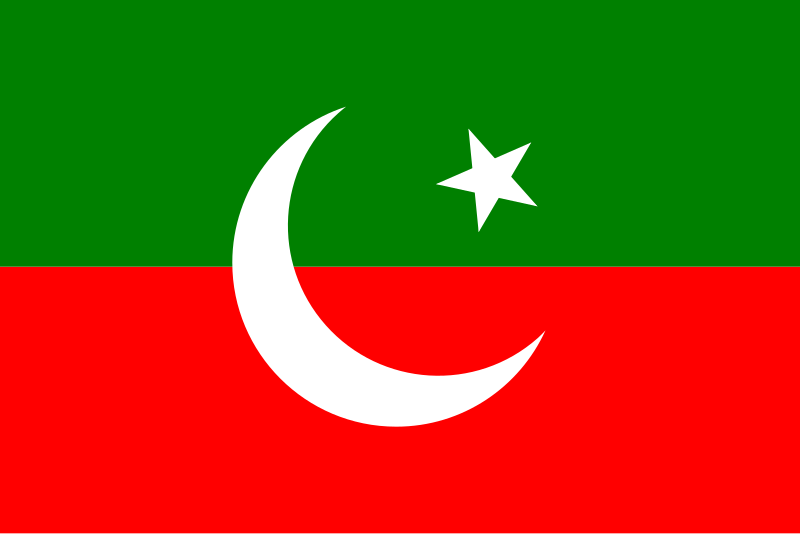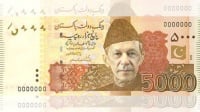This nation is in Vacation Mode for the next 165 turns. This nation cannot be attacked or traded with during that time.
| National Factbook |
| Flag: |

|
| Nation Name: |
Azaadistan |
| Leader Name: |
Ahmed Chaudhry |
| Currency: |

Khaniye |
| National Animal: |

Lion |
| History: |
In the aftermath of a revolutionary transformation, Pakistan has emerged as a new nation—Azaadistan. The name change symbolizes the country’s embrace of Haqeeqi Azadi (True Freedom), a core principle championed by the leadership of Imran Khan and the Pakistan Tehreek-e-Insaf (PTI). With the fall of the old political order, Azaadistan stands as a beacon of hope for a society freed from the shackles of corruption, inequality, and misgovernance. The nation is now guided by the dream of a truly liberated people, where justice, accountability, and transparency form the bedrock of governance. Under the Vision of Khan, the country is undergoing sweeping reforms aimed at creating a welfare state that prioritizes education, healthcare, and economic empowerment. Azaadistan’s foreign policy is independent, and its internal policies are designed to foster sustainable growth and social justice. With its new identity, the nation strives to build a future where the ideals of true freedom and equality are no longer just aspirations, but a lived reality for every citizen. |
| Geography |
| Continent: |
Asia |
| Land Area: |
12,810.35 sq. km |
| Terrain: |
The terrain of this region is strikingly diverse, featuring a mix of towering mountains, fertile plains, arid deserts, and a rich coastline. In the north, the landscape is dominated by the majestic Himalayas and the Karakoram Range, home to some of the highest peaks in the world, including the renowned K2. These mountain ranges are interspersed with deep valleys, glacial rivers, and alpine meadows, creating a dramatic and rugged environment.
To the west, the Hindu Kush mountains extend across the landscape, while the Sulaiman Mountains form an essential part of the southwestern terrain. Flowing from the northern highlands to the southern plains, the Indus River winds its way through vast agricultural lands, supporting one of the region’s most fertile zones. This river basin forms the agricultural backbone, feeding crops and sustaining a wide variety of plant and animal life.
Further south, the vast Thar Desert stretches across the southeastern region, characterized by its barren, sandy expanses and extreme heat. In contrast, the Baluchistan Plateau in the southwest is marked by dry, rugged terrain and stark rock formations, while the coastline along the Arabian Sea is known for its scenic cliffs, sandy beaches, and fishing ports. This varied landscape, with its dramatic differences in elevation and climate, supports a rich variety of ecosystems and plays a key role in the cultural and economic fabric of the region. |
| Highest Peak: |
K2,
8,611 meters
|
| Lowest Valley: |
Rann of Kutch,
-15 meters
|
| Climate: |
The climate of this region is highly varied. The northern mountains experience cold winters and cool summers, while the plains have hot summers and mild winters. The southeastern Thar Desert is arid and extremely hot, with little rainfall, while the southwestern Baluchistan Plateau has a dry, semi-arid climate with large temperature shifts between day and night. Along the coastline, the climate is more moderate, with hot, humid summers and mild winters, tempered by sea breezes and occasional monsoon rains. |
| People & Society |
| Population: |
429,005 people |
| Demonym: |
Azaadian |
| Demonym Plural: |
Azaadistanis |
| Ethnic Groups: |
Punjabi - 50.0%
Sindhi - 25.0%
Pashtun - 25.0% |
| Languages: |
English - 78.0%
Urdu - 100.0% |
| Religions: |
Islam - 92.0%
Christianity - 6.0%
Hinduism - 2.0% |
| Health |
| Life Expectancy: |
76 years |
| Obesity: |
8% |
| Alcohol Users: |
0% |
| Tobacco Users: |
38% |
| Cannabis Users: |
0% |
| Hard Drug Users: |
0% |
| Economy |
| Description: |
Azaadistan, as a newly established nation, is in the process of building a dynamic and self-reliant economy based on the principles of justice, equity, and sustainability. Under the leadership of PTI, the country is rapidly transitioning from a historically fragmented economy to a more inclusive and resilient one. The government has focused on reforms aimed at reducing corruption, promoting transparency, and creating a more business-friendly environment to attract both domestic and foreign investment.
Agriculture, once the backbone of the economy, is being modernized with the introduction of new technologies and sustainable practices. The Indus River continues to be a vital resource for irrigation, while the government is investing in improving agricultural infrastructure and supporting small farmers to boost productivity. Alongside agriculture, the country is pushing for a diversification of its economy, with an emphasis on manufacturing, renewable energy, and technology.
Azaadistan is positioning itself as a hub for green energy, leveraging its natural resources such as solar and wind power to become energy self-sufficient and reduce its carbon footprint. The country is also encouraging innovation and entrepreneurship, creating opportunities for the younger population to contribute to the digital economy, including tech startups and e-commerce.
In terms of foreign trade, Azaadistan is focusing on building strong, independent relationships with global powers, prioritizing economic diplomacy, and fostering mutually beneficial partnerships. The coastal regions along the Arabian Sea are being developed to enhance trade routes and facilitate the growth of key ports, strengthening the country’s role in regional and international commerce.
Azaadistan’s economic policies are driven by the desire to create a welfare state, ensuring that wealth is more equitably distributed, poverty is reduced, and social services like education and healthcare are accessible to all citizens. Although the country faces the challenges of being a new nation, its leadership remains committed to building a fair, prosperous, and sustainable economy that serves the needs of all its people. |
| Average Yearly Income: |
$114.28 |
| Gross Domestic Product (GDP): |
$838,898,384.00 |
| GDP per Capita: |
$1,955.45 |
| Gross National Income (GNI): |
$741,762,490.00 |
| Industries: |
Azaadistan’s industrial landscape is undergoing a major transformation as the nation seeks to diversify its economy and reduce dependency on traditional sectors. With a commitment to modernization and self-sufficiency, the government is encouraging the growth of several key industries.
Textiles and Apparel remain central to Azaadistan’s industrial base, as the country capitalizes on its skilled workforce and favorable production costs to become a competitive player in the global market. The government is focusing on improving the value-added textile sector, from raw cotton processing to high-quality garment manufacturing, while also promoting sustainable practices in the industry.
The construction and infrastructure sectors are also booming, driven by the country’s rapid urbanization and the need for modern infrastructure. Large-scale projects, such as roads, bridges, and housing developments, are being launched across the country, with significant investments in smart cities and green building technologies. These initiatives aim to foster long-term economic growth while addressing the needs of a growing population.
Renewable energy is a key area of focus for Azaadistan’s industrial future. The country is rapidly expanding its wind and solar power capacity, capitalizing on its natural resources to build a robust green energy sector. This push towards sustainable energy is not only helping to meet domestic energy needs but is also creating jobs and opportunities in the renewable energy industry.
Technology and Information Technology (IT) are becoming increasingly important as the nation builds its digital infrastructure. The government is providing incentives for tech startups, digital innovation, and the growth of IT parks, making Azaadistan an emerging hub for software development, e-commerce, and tech services. With a youthful, tech-savvy population, the country aims to create a thriving digital economy that can compete on the global stage.
Mining and natural resources also play a significant role in the country’s industrial development, particularly in the extraction of minerals and hydrocarbons from the vast reserves found in the Baluchistan Plateau and other regions. Azaadistan is working to modernize its mining sector, ensuring that natural resources are extracted sustainably and used to fuel both domestic industry and export markets.
Finally, agro-processing is gaining importance as the country seeks to add value to its agricultural output. This includes the processing of fruits, vegetables, and other primary products into packaged goods for both domestic consumption and export. By investing in agro-processing technologies, Azaadistan aims to reduce food waste, increase exports, and create employment opportunities in rural areas.
As a new nation, Azaadistan’s industrial strategy is focused on creating a diversified, resilient, and forward-thinking economy that can compete in the global marketplace while meeting the needs of its citizens. |
| Military |
| History: |
In Azaadistan, the military has undergone a profound transformation, shedding the old legacy of political interference that once marred the country’s armed forces. With the abolition of the previous system, the new Armed Forces of Azaadistan have been restructured to serve solely the people and the nation’s defense, free from any involvement in politics. The focus is now on professionalism, discipline, and loyalty to the country’s democratic values, ensuring that the military remains a force for national security rather than political power.
The new military is built on the principles of service, integrity, and accountability, with a clear mandate to defend Azaadistan’s sovereignty, protect its citizens, and assist in humanitarian efforts when needed. The armed forces are seen as a unifying institution, dedicated to safeguarding the nation’s territorial integrity and supporting the development of a peaceful, stable society.
Azaadistan’s army, navy, and air force have been modernized to meet contemporary security challenges, with a focus on technology, innovation, and readiness. The military is equipped with state-of-the-art weaponry and has embraced advanced training programs that emphasize peacekeeping, counter-terrorism, and disaster response. Strategic partnerships with international allies are also being forged to enhance Azaadistan’s defense capabilities while promoting peace and regional stability.
A key feature of Azaadistan’s military doctrine is the commitment to civil-military relations, which ensures that the armed forces focus on their primary mission of national defense while remaining fully subordinate to the democratically elected government. The military’s role in governance has been strictly curtailed, and it operates under the rule of law, with oversight from civilian authorities.
Azaadistan’s military is also deeply integrated with its development efforts, offering support in times of natural disasters, infrastructure building, and peacebuilding operations. The army’s role is thus reframed from that of a political actor to one of national service, reinforcing the idea that the military is, above all, a protector of the people and their democratic rights.
Through these reforms, Azaadistan’s military has become a modern, efficient, and people-centered force that is fully committed to securing the nation’s future without overstepping into the realm of politics. This represents a fundamental shift from the past, where the military once held significant sway over the country’s political direction, towards a more peaceful, democratic, and transparent governance model. |
| Soldiers: |
0 |
| Tanks: |
0 |
| Aircraft: |
0 |
| Ships: |
0 |
| Missiles: |
0 |
| Nuclear Weapons: |
0 |
| Last Updated: 01/22/2025 09:35 am |













